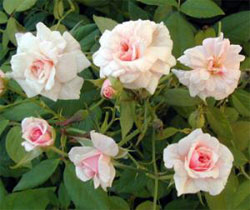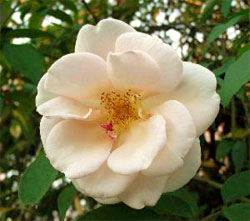Rose Cuttings – September, 2011
The Newest Earth-Kind® Roses

Cecile Brunner is familiar as the “Sweetheart Rose.” Photos courtesy of Texas A&M Horticulture.

Reve d’Or was named the 2010 Earth-Kind Rose of the Year.
Only 21 roses have proved themselves worthy of the Earth-Kind® title – a group of roses recognized through a rigorous trial program conducted by Texas AgriLife Extension, an agency of the Texas A&M System. The two newest roses to earn that designation are Cecile Brunner and Reve d’Or.
The two varieties are both sentimental old garden roses, but like the other 19 in the select group, they have demonstrated that they are “long-lived, tolerant of most any soil, and so environmentally responsible that almost never will you need to apply harsh pesticides or even commercial fertilizer,” according to Dr. Steve George. Dr. George is the Texas AgriLife Extension horticulturist who is the driving force behind the testing program.
Cecile Brunner, which has graced gardens since 1881, is popularly known as the “Sweetheart Rose.” A repeat bloomer, the rose reaches about 4 feet by 3 feet and bears small, numerous roses that are light pink and fragrant. The bush is adapted throughout Texas.
Reve ’d’Or (pronounced rehv dohr) was originally released in 1869. Its French name translates as “dream of gold.” Dr. George describes it as “the healthiest yellow rose that we have ever tested.” Judges named it the Earth-Kind® Rose of the Year in 2010.
Reve d’Or is a vigorous, but nearly thornless, climber that can reach 10 to 18 feet tall and 8 feet wide. The blooms are medium yellow and fragrant, and the rose is a repeat bloomer. The plant is adapted to all of Texas except the upper Panhandle.
To earn the Earth-Kind® designation, roses are generally tested for eight years or more. Planted in randomized plots in many parts of the state, the plants receive no fertilizer or pruning, are not treated with pesticides, and receive limited watering. They are also grown on their own roots, rather than being grafted. Little wonder that the best performers are described as “tough and easy to maintain.”
Information for this article is drawn from the extensive Texas A&M horticulture website. For more information about Earth-Kind® roses, visit http://aggie-horticulture.tamu.edu/earthkind/roses/.
